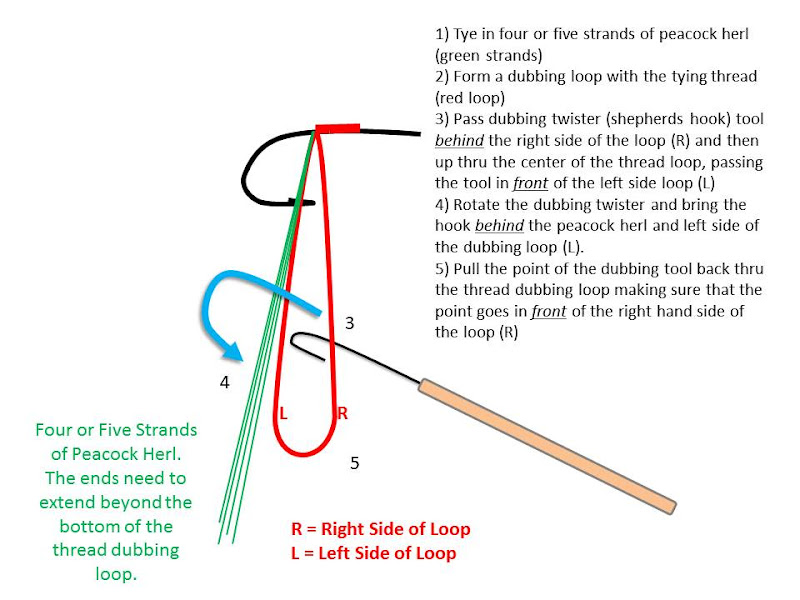Martin - I use a dubbing loop to reinforce the peacock herl. The technique basically forms a peacock chenille which can be wrapped forward to form the body of the fly. The resulting body is very durable and is nicely uniform. I learned the technique from Denny Richards (famous American stillwater tyer). The technique is simple. Explaining it is difficult. Here is the condensed version - with the dubbing hook you simply reach behind the right side of the loop to snag the herl, then the left side of the loop, then on the return you grab the right side of the loop, trapping/capturing the herl strands between the thread in the process.
Here is the long winded description of the technique (
it sounds complicated, but it is very easy once you get the hang of it)
1) Tye in four or five strands of peacock herl (green strands)
2) Form a dubbing loop with the tying thread (red loop)
3) Pass dubbing twister tool behind the right side of the loop (R) and then up thru the center of the thread loop, passing the tool in front of the left side loop (L)
4) Rotate the dubbing twister and bring the hook behind the peacock herl and left side of the dubbing loop (L).
5) Pull the point of the dubbing tool back thru the thread dubbing loop making sure that the point goes in front of the right hand side of the loop (R)
6) Now twist the tool to form a herl chenille which is reinforced with two strands of tying thread. The resulting body is very durable (no need for tinsel rib if you don't want one).
Hopefully this diagram will help explain the technique.

I often use a special bobbin (Mitch's Bobbin Whirler - sold by Wasatch /
http://www.flytyingtools.com/webpages/t ... itchs.html) to form these sorts of bodies. The process if very similar, and it is extremely easy to then wrap the body forward without interference from other tools. I generally use one of these methods when forming herl bodies (peacock, sword fibers, ostrich herl, etc.). I have had limited success with the method you described (twisting the herl around the thread). I had problems with breakage of the herl and with lumpiness in the finished bodies. Once I found these methods, I gave up on the thread-twist technique. Obviously your results may vary...

For completeness - here are a couple Youtube links showing the Mitch's bobbin whirler in operation.
http://www.youtube.com/watch?v=NglJ9ZAmSGs
http://www.youtube.com/watch?v=87DSqiMxBLo
